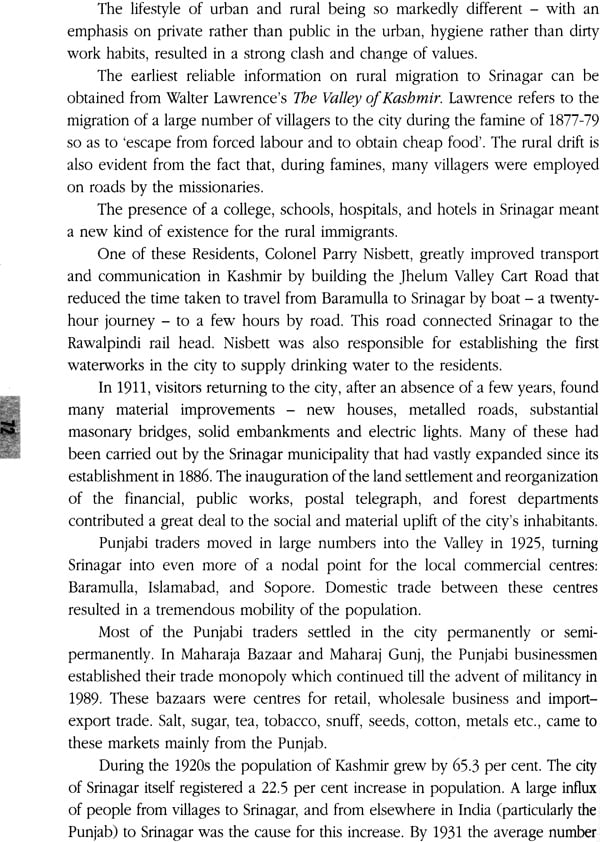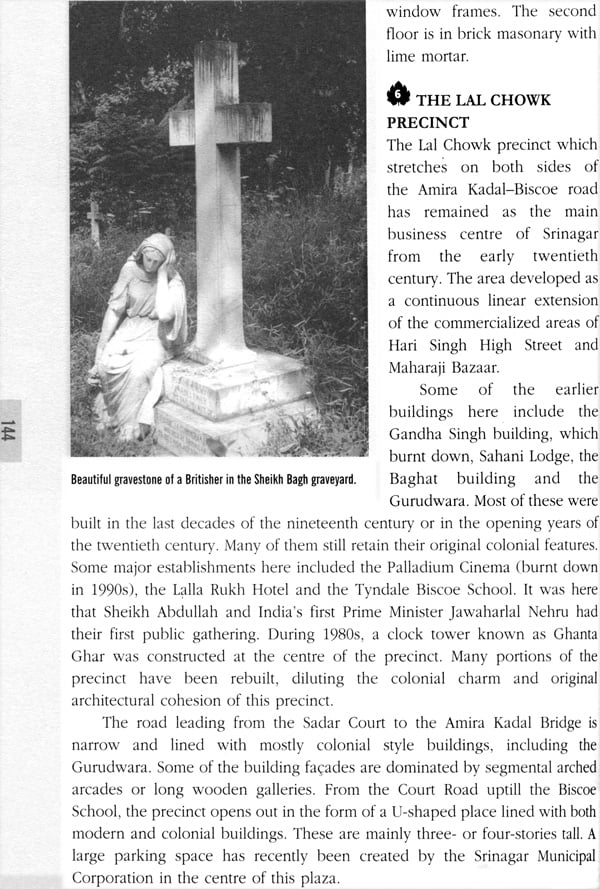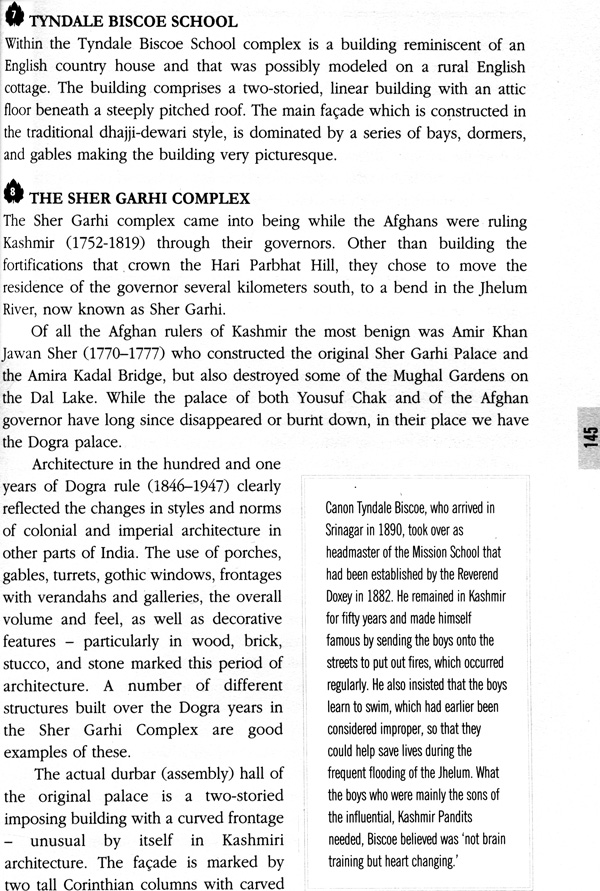
Srinagar (An Architectural Legacy)
Book Specification
| Item Code: | NAK168 |
| Author: | Feisal Alkazi |
| Publisher: | Roli Books Pvt. Ltd. |
| Language: | English |
| Edition: | 2014 |
| ISBN: | 9788174369185 |
| Pages: | 216 (Throughout B/W Illustrations) |
| Cover: | Paperback |
| Other Details | 8.5 inch x 5.5 inch |
| Weight | 330 gm |
Book Description
A unique part of India that is associated with the best living traditions in craft, cuisine, houseboats and shikaras, rushing mountain streams, and snow – clad mountains, Srinagar is a garden of paradise. Srinagar: An architectural Legacy explores the history and architectural heritage of this 500-Year – old city bringing to life its rich past, with its different eras of rules who made the Valley a part of their empire. To understand the present context of the city, the book takes on a series of walks giving readers a chance to get a sense of the architectural culture, as well as the dynamic interplay of civic life, and trade in the city.
Feisal Alkazi is an educationist, trainer, and theatre director. After a master's in social work, he headed Ankur, a society for alternatives in education for ten years, and taught at the Jamia MCRC centre for six years. He now heads Creative Learning for change (CLC), an NGO that designs, carries out and documents innovative educational projects in gender, environmental, and heritage education. Alkazi has co-authored twenty books including Exploring an Environment, The Riverfront of my town; Discovering Jaipu; and discovering Kashmir. A well know theatre director, he has directed over 300 plays for adults and children alike. His other solo publications include forever Friends Rang Biranga Rangmanch; and the soon to be published Tagore for Today.
The world over Kashmir has always been seen as a garden of paradise, scented with fresh fruits and luxuriant blossoms, symbolized by the golden chinar leaf. This is a part of India that we associated with the best living traditions of craft, wonderful cuisine, houseboats and shikaras, rushing mountain streams and snow clad peaks. It is only over the last twenty odd years (since 1989) that Kashmir has been seen as an arena of conflict.
Today as the Valley and its chief city Srinagar limp back to normalcy, we can once again appreciate that unique tradition of values, craftsmanship and an urban culture that this city has personified over the ages.
This book on Srinagar's distinctive architectural heritage attempts to place this built tradition in a specific cultural context, where environment and history combined to create a unique style. Looking at several wood and brick homes in the old city with their unusual features of pinjarakari, dubs, khatamband ceilings and dhajji – diwari construction, one can get a feel of the city as it was hundred years ago. Dotting the city at the time (and even today) were sufi shrines and distinctive Kashmiri mosques with their pyramidical three – tiered roofs, often planted with tulips, daffodils and narcissus. And in places one would have seen the beginnings of colonial architecture in stone, brick, wood and stucco. The city at the time was linked only by waterways and riverine transport, as there were few roads. Srinagar was home to the constant play of seasons: the heavy snow of writer winter that trapped everyone indoors, spring with its many blossoms, a warm summer season of fruits and a golden autumn of russet chinars. So as we uncover the layers of Kashmiri architectural heritage we can see a tapestry made up of very different strands.
This book can be used to explore the history and architectural legacy of this 500- years- old city. It is divided into distinct into two distinct parts – the attempts to bring alive the rich past with its alternate eras of sorrow and celebration, and place the style of Kashmiri architecture in a specific context. The second part lays out a series of walks, each of approximately 3- 31/2 hours duration, that give you a chance to discover the city, book in hand, and get a sense of the architectural heritage, as well as the dynamic interplay of civic life, religion and trade in the city. In the appendices you will find details of a recent, very successful architectural conservation project, the Aali Masjid, and a brief section on the best loved of kashmiri handicrafts – the shawl, papier mache, and woodcarving.
The city at the present is rapidly malls replacing colonial structures, glass and concrete replacing wood, bay windows replacing the dub much of the beauty of Kashmri residential architecture can still be seen in several houses around Ali Kadal and Zaina Kadal bridges in the old city, but this is a building tradition that may not survive. Over the past five years, the Srinagar chapter of INTACH (Indian National Trust for Art and Cultural Heritage), on the request of CHEK (Centre for Heritage and environment of Kashmir) has worked assiduously at documenting this building tradition covering 838 homes, religious buildings, commercial and administrative complexes, gardens and canals to create an impressive five – volume set of listings. The present book is based entirely on these listings and additional research in the field and in libraries.
The unique architectural heritage of Srinagar is under threat today, and it can easily turn into just any other faceless city, with no reflection of it's surrounding landscape local building material or indigenous traditions, in much of its contemporary architecture. Fortunately the city continues to be home to an extraordinary range of social, cultural and economic assets in its traditional knowledge systems, oral traditions, and in the skills of art and craft. It is only by documenting and harnessing these living traditions that steps can be taken to preserve and conserve its unique character.
| Acknowledgements | 7 | |
| Introduction | 11 | |
| 1 | The city of Srinagar | 14 |
| 2 | History its Sources, Pre-History and Early History | 29 |
| 3 | Islam in the Medieval world | 41 |
| 4 | The Mughals in the Valley | 51 |
| 5 | The Afghans, the Sikhs and the Dogras | 63 |
| 6 | The Changing City – 1850s Onwards | 69 |
| 7 | The colonial Impact | 75 |
| 8 | Sufism | 85 |
| 9 | Aspects of Islamic Architecture | 89 |
| 10 | Traditional Kashmiri Residential Architecture | 103 |
| Walk 1 From medieval to Colonial Srinagar | 118 | |
| Walk 2 A walk along the Bund | 134 | |
| Walk 3 A garland of Gardens | 150 | |
| Walk 4 Exploring Hari Parbat | 162 | |
| Walk 4 Of Mosques and Khanqahs | 172 | |
| Walk 6 Moving Back in Time from Ali Kadal | 183 | |
| Appendices | ||
| Srinagar in the Mughal Period | 190 | |
| The Sufi was | 191 | |
| Aali Mashid | 192 | |
| Craft Traditions in the Valley | 196 | |
| index | 204 |









